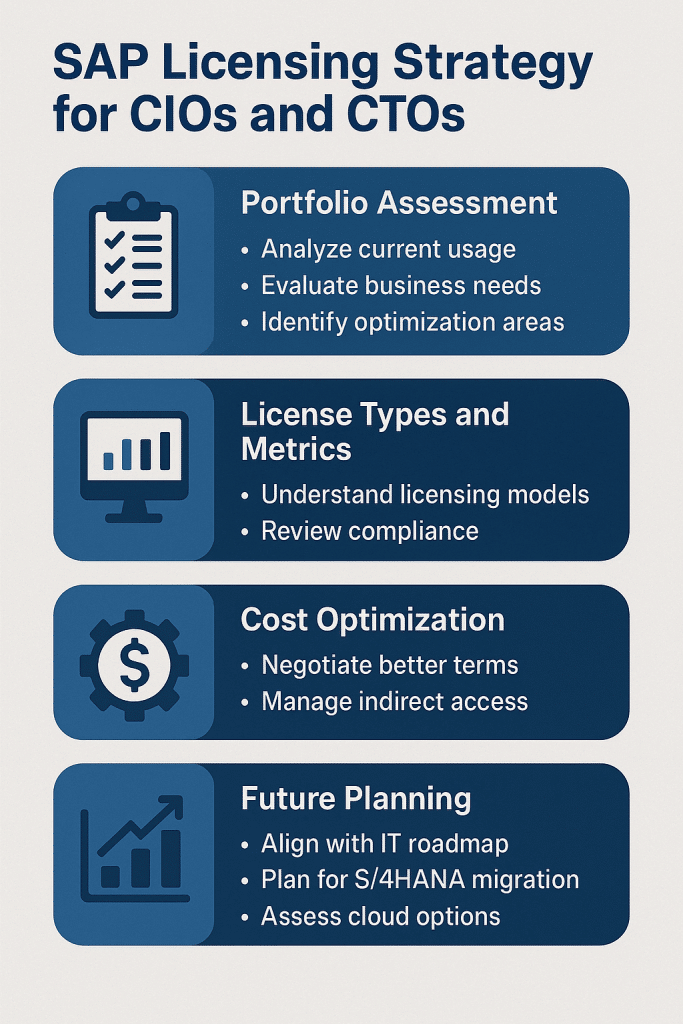
SAP Licensing Strategy for CIOs and CTOs
SAP’s licensing is complex and constantly changing, blending old on-premise models with new cloud subscriptions. CIOs and CTOs require a proactive approach to manage costs and maintain compliance.
This article guides understanding key license models, avoiding common pitfalls, and negotiating agreements that safeguard your IT budget.
SAP License Models and Types
SAP offers two primary models: perpetual licenses (purchased once, run on your servers, with ~22% annual support) and subscription licenses (cloud-based subscription, paying recurring fees that include support and infrastructure).
Most SAP licenses are sold per Named User – each user gets a license type (Professional, Limited, etc.) based on their role.
There are also package/engine licenses for specific modules measured by business metrics (like number of employees, sales orders, or CPU cores).
SAP Licensing Cost Overview: (Illustrative)
| License Model | How It Works | Cost Structure |
|---|---|---|
| Perpetual (On-Prem) | One-time purchase; you own the software and run it on your infrastructure. Requires annual support for updates. | One-time fee + ~22% per year support. Eg: ~$3,000 per user + $660/yr support. |
| Subscription (Cloud) | Recurring subscription; SAP hosts and manages the system in the cloud. Support is included. | Ongoing fee (OpEx). Eg: ~$150 per user per month for S/4HANA Cloud (including support). |
Key Licensing Challenges and Risks
Even a well-planned SAP environment can hit snags:
- Licensing Mismatch: If the number of users or transactions outgrows what you purchased, you’re under-licensed (a compliance problem). On the other hand, buying far more licenses than needed leads to shelfware and wasted expenditure. Regularly realign licenses to actual usage.
- Indirect Access: Third-party systems or interfaces that connect to SAP (like a web portal creating orders in SAP) trigger license requirements under SAP’s digital access rules. If indirect usage isn’t licensed (via additional named users or document licenses), an audit could result in a substantial bill.
S/4HANA Migration and Cloud Impacts
SAP’s ECC support is set to end in 2027, prompting plans for S/4HANA. RISE with SAP (S/4HANA cloud subscription) bundles software, infrastructure, and support under one contract, and SAP is offering incentives to entice customers.
However, consider the multi-year cost – a subscription can end up being pricier than keeping your current system on support.
Sometimes, staying on your existing licenses longer is more cost-effective. Use your upgrade plans as leverage – SAP often offers better deals to help you transition to S/4HANA.
Optimizing License Usage and Cost
To get more value from your SAP investment:
- Self-Audit Regularly: Run SAP’s license measurement tools periodically to spot inactive users or wrong license assignments. Clean these up to avoid paying for accounts no one is using.
- Recycle Licenses: When staff leave or change roles, reassign their licenses instead of buying new ones. Have a process so licenses don’t sit unused.
- Eliminate Shelfware: Identify any licenses or subscriptions you’re not using. If you’re paying maintenance on unused licenses, consider negotiating with SAP to retire or swap them for licenses you need (or reduce the count at renewal).
Negotiation Tactics for SAP Contracts
Negotiating with SAP is critical to controlling costs:
- Do Your Homework & Insist on Discounts: Know your actual usage and needs, and never pay list price. Use that data to push for volume discounts and cap any future fee increases.
- Build in Flexibility: Include terms that let you adjust if things change. For example, allow swapping of license types or scaling user counts down at renewal. This helps avoid paying for excess.
Recommendations
- Establish governance – Assign a dedicated owner or team to manage SAP licenses and review usage regularly.
- Keep licenses tidy – Remove or reallocate unused accounts promptly to avoid paying for idle licenses.
- Use SAP’s offers – Take advantage of programs (migration credits, digital access discounts) to cut costs when expanding or re-licensing.
- Time your renewals – Align contract renewals with major projects (like upgrades) so you can negotiate trade-ins or better terms when SAP wants your new business.
FAQ
Q1: Why is SAP licensing so complicated?
A: SAP’s vast product range and decades of changing rules make it complex. You’ll need a dedicated licensing expert or specialized tools to keep track and stay compliant.
Q2: What’s the benefit of RISE with SAP vs. traditional licensing?
A: RISE with SAP is a cloud subscription (SAP runs and updates your system) while traditional licensing means you run it yourself. RISE is simpler, but you surrender some control and commit to continuous fees; traditional is more work, but can cost less over time if you already own licenses.
Q3: How can we avoid paying for SAP licenses we aren’t using?
A: Audit your SAP usage regularly and free up any unused licenses. Remove or reassign licenses from people who left, and drop unused modules or users at the next renewal.
Q4: What is “indirect access” and why does it matter?
A: Indirect access occurs when external systems or users (via APIs, etc.) utilize SAP data without a direct login, and it still requires licensing (usually via SAP’s document model). If you ignore it, an audit will find it. Document all such integrations and license them appropriately (SAP’s digital access program offers discounts to help).
Q5: Any tips for negotiating a better SAP deal?
A: Be fully prepared with data on what you have and need, and don’t accept SAP’s first offer. Negotiate beyond price – ask for terms like caps on support increases or flexibility to adjust licenses. Ensure SAP is aware that you have alternatives or are willing to wait; they’ll usually improve the deal if they believe you might walk away.
Read more about our SAP Licensing Services.